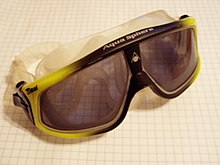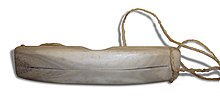Goggles: Difference between revisions
m Reverted edits by 204.81.85.95 (talk) to last version by VoABot II |
No edit summary |
||
| Line 64: | Line 64: | ||
[[simple:Goggles]] |
[[simple:Goggles]] |
||
[[sv:Skyddsglasögon]] |
[[sv:Skyddsglasögon]] |
||
[[richard simmons]] |
|||
Revision as of 22:32, 15 February 2008



Goggles (ie- safety glasses) are forms of protective eyewear that usually enclose or protect the eye area in order to prevent particulates, water or chemicals from striking the eyes. They are used in chemistry laboratories and in woodworking. They are often used in snow sports as well, and in swimming. Goggles are often worn when using power tools such as drills or chainsaws to prevent flying particles from damaging the eyes. Many types of goggles are available as prescription goggles for those with vision problems.
Goggles (ie- Virtual reality headset) are used as a wrap-around visual interface to computer display output. Commonly the computer display information is presented as a three-dimensional representation of real-world environments.
History
The Eskimos carved goggles from caribou antler, as well as wood and shell, to help prevent snowblindness. The goggles were curved to fit the user's face and had a large groove cut in the back to allow for the nose. A long thin slit was cut through the goggles to allow in a small amount of light, diminishing subsequent Ultraviolet rays. The goggles were held to the head by a cord made of caribou sinew.
Most modern cold-weather goggles have two layers of lens to prevent the interior from becoming “foggy.” With only a single lens, the interior water vapor condenses onto the lens because the lens is colder than the vapor. The reasoning behind dual layer lens is that the inner lens will be warm while the outer lens will be cold. As long as the temperature of the inner lens is close to that of the interior water vapor, the vapor should not condense. However, if water vapor gets between the layers of the lens, condensation can occur between the lenses and is almost impossible to get rid of; thus, properly constructed and maintained dual-layer lenses should be air-tight to prevent water vapor from getting in between the lenses.
The requirements for goggles varies depending on the use. Some examples:
- Swimming: Must be watertight to prevent water, such as salt water when swimming in the ocean, or chlorinated water when swimming in the pool, from irritating the eyes or blurring vision. Allows swimmers to see clearly underwater. They will not be usable more than a few feet underwater, because the water pressure will press them tightly against the face.
- Power tools: Must be made of an unbreakable material that prevents chunks of metal, wood, plastic, concrete, and so on from hitting or piercing the eye. Usually has some sort of ventilation to prevent sweat from building up inside the goggles and fogging the surface.
- Motorcycle riding and other open-air activities: Prevents insects, dust, and so on from hitting the eyes.
- Laboratory: Combines impact resistance with side shields to prevent chemical splashes reaching the eyes. May also include laser protection.
- Racquetball: Protect the eyes from racquets swinging in an enclosed area and from impact from hard rubber ball.
- Snow sports: Protect the eyes from glare and from icy particles flying up from the ground.
- Astronomy and meteorology: dark adaptor goggles are used before going outside at night, in order to help the eyes adapt to the dark.
- Basketball: Several NBA players have worn goggles during play, including Kareem Abdul-Jabbar, James Worthy, Horace Grant and Kurt Rambis; they prevent a fellow player from scratching or hitting the eyes when trying to grab the basketball.

Fashion
Goggles are often worn as a fashion statement in certain subcultures, most often as part of the cybergoth subculture. They are usually worn over the eyes or up on the forehead to secure 'falls': a type of long, often brightly-coloured, synthetic hairpiece. Fans of the Steampunk genre or subculture also frequently wear steampunk-styled goggles, particularly when performing in a LARP.
Popular Culture
Goggles are part of a meme stemming from a quote from the Radioactive Man episode of The Simpsons where Rainier Wolfcastle is faced with a tidal wave of sulfuric acid while filming a movie, his only provided safety precaution a pair of rubber safety goggles intended to deflect small amounts of acid. When the scene goes horribly wrong, he is swept away, his suit and prop goggles dissolving, spurring him to yell, "My eyes! The goggles do nothing!" This line is commonly misquoted as "The goggles! They do nothing!"
